Table of Contents
-
- Introduction
- How to Create a Logo That Reflects Your Brand’s Values
- The Role of Logo Design in Brand Recognition and Recall
- Strategies for Crafting a Memorable Logo
- The Importance of Simplicity in Logo Design
- How to Incorporate Color Psychology into Logo Design
- Tips for Choosing the Right Fonts for Your Logo
- The Benefits of Working with a Professional Logo Designer
- Conclusion
“Design Your Brand with Professional Tips – Create a Logo that Lasts!”
Introduction
Designing logos and branding is an important part of any business. It is the first thing that customers and potential customers see when they come across your business. It is also the first impression that they have of your business. Therefore, it is important to make sure that your logo and branding are professional and attractive. In this article, we will discuss some professional tips for designing logos and branding that will help you create a logo and branding that will make a lasting impression on your customers. We will discuss the importance of research, the use of colors, typography, and other design elements. We will also discuss the importance of consistency and how to create a logo and branding that will stand out from the competition.
How to Create a Logo That Reflects Your Brand’s Values

1. Identify Your Brand’s Values: Before you can create a logo that reflects your brand’s values, you must first identify what those values are. Take some time to think about what your brand stands for and what it wants to communicate to its customers.
2. Research Logo Design Trends: Once you have identified your brand’s values, research the latest logo design trends to get an idea of what type of logo would best represent your brand. Look at logos from other brands in your industry and take note of the elements they use.
3. Create a Mood Board: Create a mood board with images, colors, and fonts that reflect your brand’s values. This will help you visualize the type of logo you want to create.
4. Brainstorm Ideas: Brainstorm ideas for your logo. Think about how you can incorporate your brand’s values into the design.
5. Create a Draft: Once you have a few ideas, create a draft of your logo. Use the mood board you created to help you refine the design.
6. Get Feedback: Ask for feedback from friends, family, and colleagues. This will help you make sure that your logo accurately reflects your brand’s values.
7. Finalize Your Logo: Once you have received feedback, make any necessary changes and finalize your logo.
Creating a logo that reflects your brand’s values is an important step in establishing a strong and recognizable identity. By following these steps, you can ensure that your logo accurately reflects your brand’s values and helps to create a strong and recognizable brand identity.
The Role of Logo Design in Brand Recognition and Recall

Logo design should be simple and memorable. A logo should be easy to recognize and recall, and it should be able to convey the company’s message in a few seconds. It should also be versatile, so that it can be used in a variety of contexts, such as on websites, business cards, and other marketing materials.
The colors used in a logo can also have an impact on brand recognition and recall. Colors can evoke certain emotions and associations, and they can help to create a strong visual identity for a brand. For example, a bright and cheerful color palette can help to create a positive impression, while a more muted palette can convey a sense of sophistication and professionalism.
Finally, logo design should be consistent across all platforms. A logo should look the same on a website, business card, and other marketing materials. This helps to create a unified brand identity and makes it easier for customers to recognize and recall a brand.
In conclusion, logo design plays an important role in brand recognition and recall. A well-designed logo should be simple, memorable, versatile, and consistent across all platforms. By creating a strong visual identity, a logo can help to create a lasting impression and make it easier for customers to remember and recognize a brand.
Strategies for Crafting a Memorable Logo

2. Make it Unique: Your logo should stand out from the competition. Consider using a unique shape, color, or font to make your logo memorable.
3. Consider Your Audience: Think about who your target audience is and design a logo that appeals to them.
4. Use Visual Hierarchy: Use size, color, and placement to create a visual hierarchy that draws attention to the most important elements of your logo.
5. Use Negative Space: Negative space can be used to create interesting shapes and add depth to your logo.
6. Incorporate Meaning: Consider adding a hidden meaning or symbolism to your logo to make it more memorable.
7. Test It: Test your logo on different backgrounds and in different sizes to make sure it looks good in all contexts.
The Importance of Simplicity in Logo Design

A simple logo design is easier to recognize and recall. It should be easy to identify and should be able to convey the company’s message in a few seconds. A complex logo design can be difficult to remember and can be easily forgotten. A simple logo design should be able to communicate the company’s message without being too complicated.
A simple logo design should also be versatile. It should be able to be used in a variety of mediums, such as print, web, and television. A complex logo design may not be able to be used in all mediums, which can limit its effectiveness. A simple logo design should be able to be used in all mediums, allowing it to reach a wider audience.
A simple logo design should also be timeless. It should be able to stand the test of time and remain relevant for years to come. A complex logo design may become outdated quickly, as trends and styles change. A simple logo design should be able to remain relevant for years to come.
In conclusion, simplicity is key when it comes to logo design. A simple logo design should be easy to recognize and recall, versatile, and timeless. It should be able to communicate the company’s message without being too complicated. A simple logo design is an important part of any business’s branding strategy and should not be overlooked.
How to Incorporate Color Psychology into Logo Design

When selecting colors for a logo, it is important to consider the associations that people have with each color. For example, red is often associated with energy, passion, and excitement, while blue is associated with trustworthiness and reliability. Additionally, colors can have different meanings in different cultures, so it is important to research the cultural associations of the colors you are considering.
Once you have selected the colors for your logo, you can use them to create a visual hierarchy. This means that you can use colors to draw attention to certain elements of the logo, such as the company name or slogan. For example, you could use a bright, vibrant color for the company name to draw attention to it, while using a more muted color for the background.
Finally, it is important to consider how the colors interact with each other. Colors that are too similar can create a dull, uninteresting logo, while colors that are too different can be jarring and distracting. It is important to find a balance between colors that are complementary and colors that contrast.
By incorporating color psychology into logo design, businesses can create logos that evoke the desired emotions and behaviors in their target audience. By carefully selecting colors and creating a visual hierarchy, businesses can create logos that are both visually appealing and emotionally resonant.
Tips for Choosing the Right Fonts for Your Logo

2. Keep It Simple: When it comes to logos, less is often more. Choose a font that is easy to read and doesn’t have too many decorative elements. A simple font will help ensure that your logo is memorable and recognizable.
3. Consider the Context: Think about where your logo will be used. If it will be used in print, you may want to choose a font that is easy to read in small sizes. If it will be used online, you may want to choose a font that is optimized for web use.
4. Test It Out: Once you have narrowed down your font choices, test them out by creating a mockup of your logo. This will help you get a better sense of how the font looks in the context of your logo.
5. Get Professional Advice: If you’re still unsure about which font to choose, consider getting professional advice from a graphic designer. They can help you select the right font for your logo and ensure that it looks great.
The Benefits of Working with a Professional Logo Designer

A professional logo designer will take the time to understand your business, its goals, and its target audience. This allows them to create a logo that is tailored to your specific needs and that will help to differentiate your business from the competition.
A professional logo designer will also be able to provide you with a range of options to choose from. They will be able to create a logo that is unique and that stands out from the crowd. They will also be able to provide you with a range of different formats, such as vector files, so that you can use your logo on a variety of different platforms.
Finally, a professional logo designer will be able to provide you with advice and guidance throughout the design process. They will be able to provide you with feedback and suggestions to ensure that your logo is as effective as possible. This will help to ensure that your logo is memorable and that it will help to build your brand.
Conclusion
In conclusion, professional tips for designing logos and branding are essential for any business looking to create a strong and recognizable brand. By following these tips, businesses can create a logo that is unique, memorable, and communicates their brand message effectively. Additionally, businesses should consider the importance of consistency in their branding, as well as the use of colors, fonts, and shapes to create a cohesive and recognizable brand identity. With the right design and branding strategy, businesses can create a logo and brand that will stand out from the competition and help them to build a successful business.
If you’re looking to create a logo and branding for your business, then look no further! Check out this YouTube channel for professional tips and advice on designing logos and branding: YouTube Channel. Get started today and create a logo and branding that will make your business stand out!




No Comments